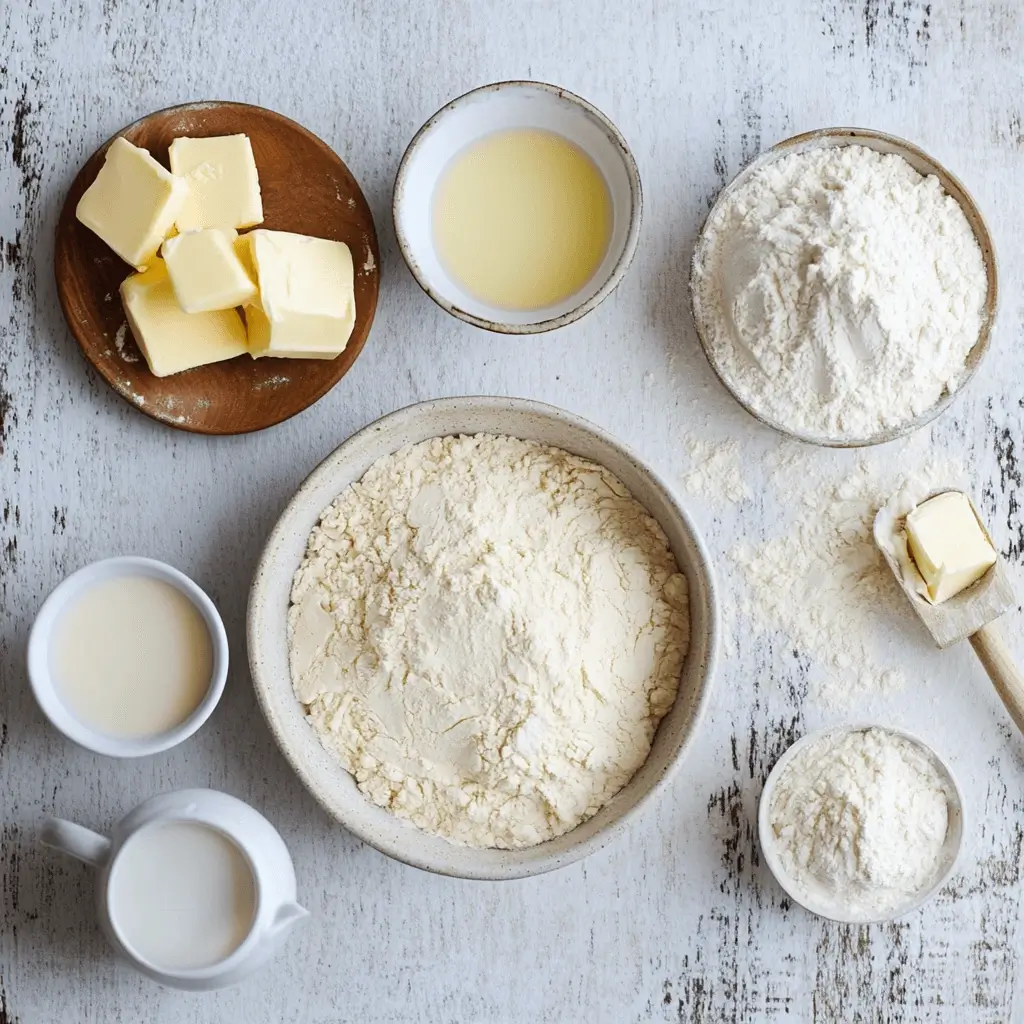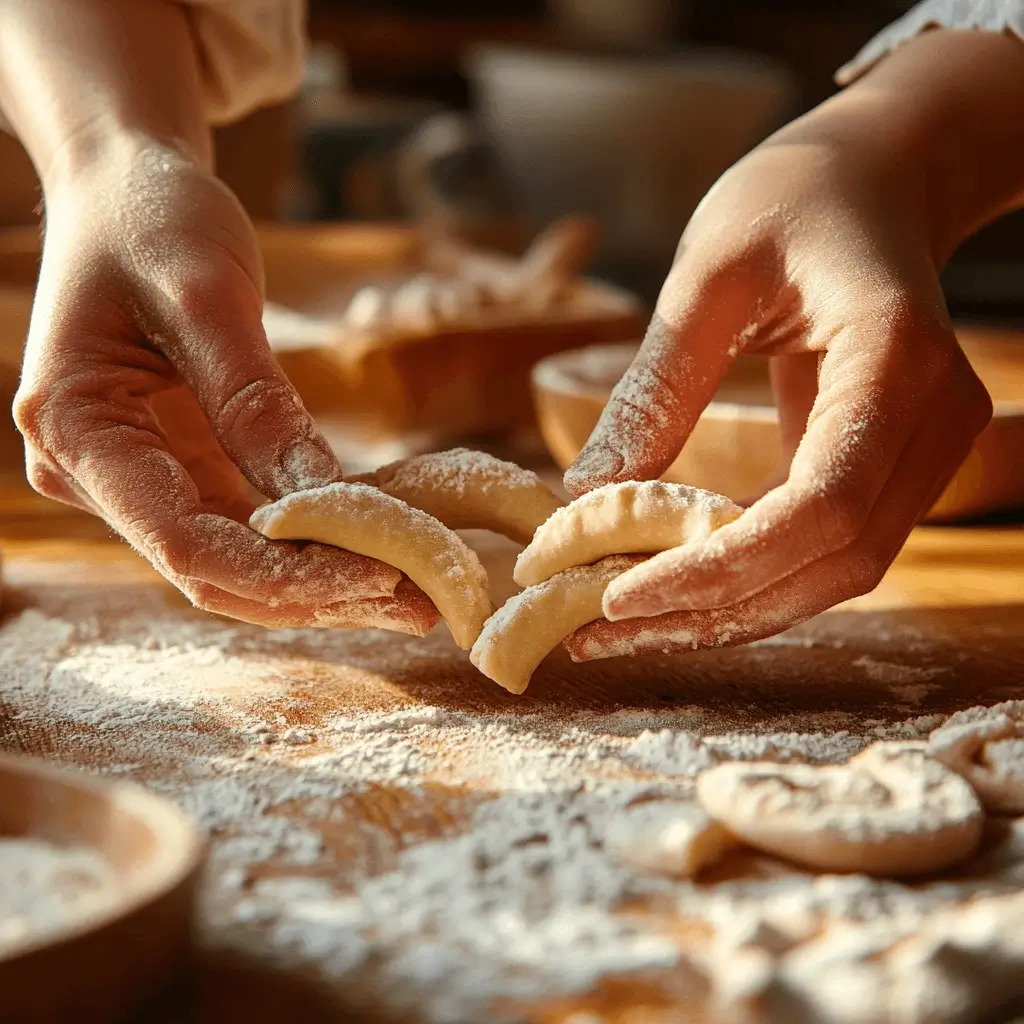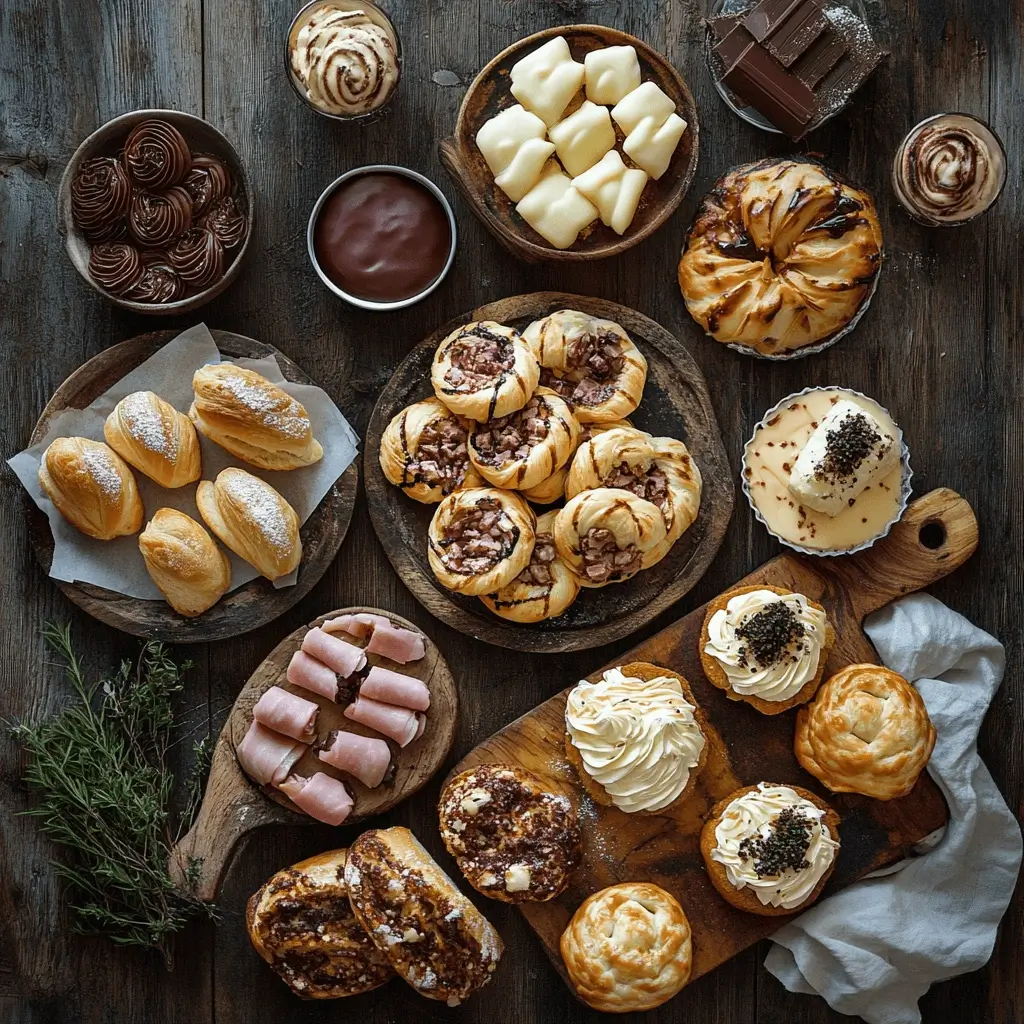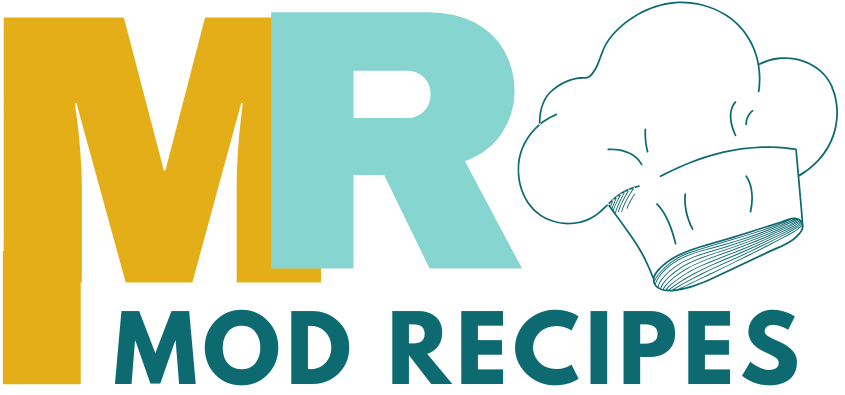Introduction
If you’ve ever wandered into a Swiss bakery early in the morning, chances are the warm, buttery scent of freshly baked Gipfeli stopped you in your tracks. Often described as Switzerland’s answer to the French croissant, the Gipfeli is a beloved breakfast staple—flaky on the outside, soft on the inside, and just the right balance between rich and airy. If you’ve ever wanted to try making this delicious pastry at home, you’ll need a good Gipfeli recipe.
But here’s the good news: you don’t need a Swiss passport or a plane ticket to enjoy this Alpine delicacy. In this post, I’ll walk you through an easy Gipfeli recipe you can recreate right at home, no culinary degree required. Whether you’re after the classic Swiss croissant or a fun twist with savory or sweet fillings, this step-by-step guide has got you covered.
Get ready to roll (literally), as we dive into the art of homemade Swiss pastries, from choosing the right ingredients to mastering that flaky finish. Let’s bring a bit of Switzerland to your breakfast table.
What Is a Swiss Gipfeli?
Origins of the Gipfeli
The Gipfeli (plural: Gipfeli, singular also sometimes referred to as Gipfel) is Switzerland’s beloved take on the croissant. Its name comes from the German word for “peak” or “crescent,” reflecting its crescent-moon shape. While it may resemble its French cousin at first glance, the Gipfeli has carved out its own unique identity in Swiss culinary culture.
Traditionally served as a breakfast item or light snack, the Gipfeli is deeply embedded in Swiss daily life—from bustling urban cafés in Zürich to quiet Alpine villages. It’s not just food—it’s a routine, a comfort, and for many, a taste of home.
Gipfeli vs. French Croissant
Think of the Gipfeli as the croissant’s more practical cousin. While French croissants are famously buttery and ultra-flaky, Gipfeli are typically denser, slightly less rich, and a bit more structured. The Swiss version uses less butter in the lamination process and often has a dough that’s closer to a mix of croissant and bread roll.
Many Gipfeli are also less sweet, making them a perfect canvas for both savory and sweet fillings—think cheese and ham, or a swipe of apricot jam.
When and How It’s Eaten in Switzerland
In Switzerland, Gipfeli are a breakfast essential, commonly enjoyed with coffee or tea. Bakeries open early to serve fresh batches, and locals often grab one on the go or linger in cafés for a quiet morning ritual. They’re also a staple of weekend brunch tables, sometimes served alongside cheese, butter, jam, or even cold cuts.
Whether you’re pairing it with a strong espresso or wrapping one to-go, the Gipfeli is as versatile as it is delicious—and now, you’re about to learn how to make your own.
Ingredients for an Authentic Gipfeli Recipe
Getting the perfect Gipfeli starts with the right ingredients. While the method plays a big role in achieving those signature flaky layers, what you put into the dough lays the foundation for flavor and texture. Luckily, you won’t need anything exotic—just good-quality staples and a bit of patience.

Basic Dough Ingredients
To make a classic Swiss Gipfeli dough from scratch, you’ll need:
- All-purpose flour – Provides structure; Swiss recipes sometimes mix in a bit of spelt or white bread flour for extra strength.
- Milk – Adds richness and tenderness to the dough.
- Butter – Essential for lamination and flavor. Use unsalted, high-fat European-style butter if possible.
- Active dry yeast – For a gentle rise and soft interior.
- Sugar – Just enough to balance the flavor, but not overly sweet.
- Salt – Enhances all the other ingredients.
- Egg – Often used in the dough and again for the final egg wash.
These ingredients form the backbone of a traditional homemade gipfeli, giving it its mild, slightly savory profile and fluffy inside.
Optional Add-ins or Fillings
Gipfeli are wonderfully versatile. Once you’ve mastered the base, try these popular variations:
- Ham and cheese – A café classic for a more filling option.
- Nutella or chocolate – For a sweet breakfast or dessert version.
- Almond paste – For a luxurious, bakery-style twist.
- Spinach and feta – For a savory, Mediterranean-style brunch.
These fillings can be added before rolling the dough into its crescent shape—just don’t overstuff, or you’ll lose those beautiful layers.
Tools You’ll Need
No fancy equipment required, but a few basics will make the job easier:
- Rolling pin – To laminate and shape the dough.
- Pastry brush – For applying egg wash evenly.
- Sharp knife or pizza cutter – To divide the dough into triangles.
- Baking tray + parchment paper – For easy transfer and cleanup.
- Cling film or clean towel – To cover the dough during resting.
Once everything’s in place, you’re ready to bring your Swiss croissants to life—let’s move on to the method.
Step-by-Step Instructions to Make Flaky Swiss Croissants
Making Gipfeli recipe from scratch may seem like a baker’s Everest, but it’s easier than it looks—especially if you break it down into manageable steps. The secret? Cold butter, gentle handling, and a bit of patience. Follow this process, and you’ll be rewarded with beautifully flaky Swiss croissants that rival any bakery.
Preparing the Dough
- Activate the Yeast: In a small bowl, combine warm (not hot) milk with sugar and yeast. Let it sit for about 5–10 minutes until frothy.
- Mix the Dough: In a large mixing bowl, combine flour and salt. Add the yeast mixture, softened butter, and a beaten egg. Mix until the dough forms a soft ball.
- Knead and Rest: Knead the dough for about 8–10 minutes until smooth and elastic. Place it in a lightly oiled bowl, cover, and let rise for 1–2 hours or until doubled in size.
Rolling and Folding
This is the lamination step—the key to those flaky, buttery layers.
- Chill Your Butter: Flatten cold butter into a square between two sheets of parchment paper. Keep it cold but pliable.
- Roll Out the Dough: On a floured surface, roll the dough into a rectangle about twice the size of your butter slab.
- Enclose the Butter: Place the butter in the center and fold the dough over it like a letter. Seal the edges tightly.
- Fold and Chill: Roll out, fold into thirds again (like a letter), wrap in cling film, and chill for 30 minutes. Repeat the folding and chilling 2 more times. This builds the flaky layers.
Pro tip: Work quickly and keep everything cold—warm butter melts into the dough, ruining the lamination.
Shaping and Baking

- Final Roll-Out: Roll the dough into a large rectangle about 5 mm thick. Cut into triangles using a knife or pizza cutter.
- Shape the Gipfeli: Starting from the wide end, roll each triangle into a crescent shape. Curve the ends slightly inward.
- Second Rise: Place on a lined baking tray, cover loosely, and let rise again for 30–45 minutes until puffy.
- Apply Egg Wash: Brush each Gipfeli with beaten egg for a shiny, golden finish.
- Bake: Bake in a preheated oven at 200°C (390°F) for 15–20 minutes, or until beautifully golden and crisp on top.
Let them cool slightly—but not too much!—before enjoying your fresh homemade Swiss pastries.
Gipfeli Variations You’ll Love
One of the most delightful things about Gipfeli recipe is their versatility. Once you’ve mastered the classic dough, the possibilities for personalization are nearly endless. Whether you’re craving something sweet with your morning coffee or a savory option for brunch, these variations will elevate your homemade Swiss croissants to the next level.
Savory Fillings
If you’re more of a salty-savoury breakfast person, these options are for you:
- Ham and Cheese Gipfeli – Add a thin slice of cooked ham and a stick of Swiss cheese (like Emmental or Gruyère) before rolling up the triangle.
- Spinach and Feta – A spoonful of sautéed spinach and crumbled feta creates a rich, Mediterranean twist.
- Bacon and Onion – Crispy bacon bits and caramelized onions add a deep, smoky flavor.
These are ideal for brunch spreads or packed lunches, and they pair beautifully with a mild mustard or herbed crème fraîche on the side.
Sweet Treats
Time to satisfy your sweet tooth—these versions are bakery favorites for a reason:
- Chocolate Gipfeli – Place a small chocolate bar or chocolate chips at the base of the triangle and roll. Sprinkle with a dusting of icing sugar after baking.
- Almond Paste – Add a thin ribbon of almond paste or frangipane inside. Top with sliced almonds before baking for crunch and visual flair.
- Fruit Preserves – A spoonful of apricot or raspberry jam makes for a delicate and fruity breakfast option.
These sweet versions are great for kids and perfect with a cappuccino or hot cocoa.

Vegan or Healthier Alternatives
Looking for lighter or plant-based options? No problem:
- Vegan Butter Substitution – Use a high-fat vegan butter alternative and plant milk for a dairy-free version.
- Whole Wheat Blend – Mix whole wheat and white flour for added fiber and a nuttier taste.
- Sugar-Free Dough – Reduce or skip the sugar entirely if using sweet fillings to maintain balance.
These variations allow you to enjoy Gipfeli with a little less guilt—and just as much satisfaction.
From brunch guests to picky eaters, there’s a Gipfeli variation for everyone. Don’t be afraid to experiment—you might just invent your own Swiss-inspired signature flavor.
Tips, Storage, and Serving Suggestions
Once you’ve baked your flaky homemade Gipfeli, the last thing you want is to lose all that hard-earned crispness or let them go to waste. This section will help you make the most of your fresh Swiss croissants—from mastering texture to keeping them delicious for days.
Expert Tips for Perfect Texture
Achieving bakery-style layers at home is possible with a few key practices:
- Keep the butter cold – Always chill your dough between folds to prevent the butter from melting into it.
- Don’t overwork the dough – Over-kneading can make it tough instead of tender.
- Use steam in the oven – Place a small dish of water on the bottom rack to help create a beautifully puffed, glossy crust.
- Don’t rush the second rise – Give the shaped Gipfeli time to puff up again; it makes a big difference in flakiness.
Patience is your best ingredient—don’t skip the resting and rising steps.
How to Store and Reheat
Gipfeli are best enjoyed fresh, but they can still be delightful the next day with proper storage:
- Short-Term: Keep them in an airtight container at room temperature for up to 2 days.
- Freezing: Wrap individually in cling film and freeze for up to 2 months.
- Reheating: For the best results, reheat in the oven at 160°C (320°F) for 5–7 minutes. Avoid microwaving—this will make them soggy.
You can also freeze the unbaked shaped Gipfeli and bake them fresh when needed.
Serving Ideas for Breakfast or Brunch
Make your Swiss breakfast spread shine with these elegant serving suggestions:

- Simple and Classic: Pair a plain Gipfeli with butter, honey, or homemade jam.
- Continental Style: Serve with cheese slices, cold cuts, and fresh fruit.
- Gourmet Touch: Drizzle sweet versions with a glaze or dust with powdered sugar before serving.
Add a pot of strong coffee or a creamy hot chocolate, and you’ve got a breakfast worthy of a Swiss chalet.
Frequently Asked Questions (FAQ)
What is the difference between Gipfeli and croissant?
While both are crescent-shaped pastries, Gipfeli recipe are typically denser, less buttery, and less flaky than French croissants. They’re often slightly savory and more bread-like in texture, making them suitable for both sweet and savory fillings.
Can I make Gipfeli without yeast?
Traditional Gipfeli recipe use yeast for a light rise and soft interior, but you can experiment with baking powder for a quick version. However, you’ll lose some of the fluffiness and laminated texture that define classic Swiss Gipfeli.
How do I store homemade Gipfeli?
Store cooled Gipfeli in an airtight container at room temperature for up to 2 days. For longer storage, freeze them individually and reheat in the oven at 160°C (320°F) for 5–7 minutes.
Can I use puff pastry instead of making the dough from scratch?
Yes, store-bought puff pastry can be a convenient shortcut for making quick Gipfeli recipe. While the flavor and texture may differ slightly from traditional dough, it’s a great option for beginners or when you’re short on time.
What are the best fillings for Gipfeli?
Popular sweet fillings include chocolate, almond paste, or fruit preserves, while savory favorites include ham and cheese, spinach and feta, or bacon and onion. Just avoid overstuffing to maintain those flaky layers.
Can I make vegan Gipfeli?
Absolutely. Use plant-based butter and milk alternatives, and skip the egg wash or use a soy milk glaze. The result will still be beautifully golden and flaky, just with a dairy-free twist.
Conclusion
There’s something undeniably comforting about the aroma of fresh, buttery Gipfeli recipe wafting through your kitchen. Whether you’re looking to recreate a cozy Swiss breakfast or simply want to try your hand at a flaky, homemade pastry, this easy Gipfeli recipe offers everything you need to get started no fancy bakery required.
With simple ingredients, clear steps, and endless room for customization, making Swiss croissants at home is a rewarding experience that blends tradition with creativity. From classic versions to sweet or savory twists, there’s a Gipfeli for every palate and every occasion.
So go ahead roll up your sleeves, preheat the oven, and bring a little slice of Switzerland into your morning routine. And if you try any fun variations, I’d love to hear about them in the comments!

